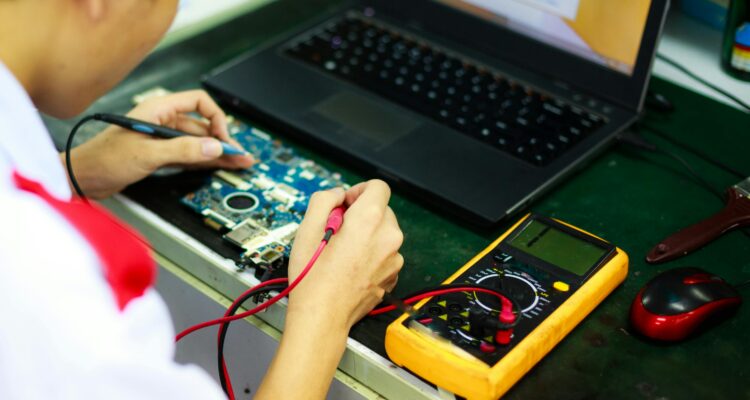Is your once-speedy computer now crawling at a snail’s pace? You’re not alone. Whether you’re dealing with a sluggish laptop or a desktop that takes forever to boot up, a slow computer can seriously impact your productivity and cause endless frustration.
The good news is that most performance issues can be resolved without spending hundreds on a new machine. This comprehensive guide will walk you through the most effective methods to speed up your slow laptop or desktop, from simple software tweaks to strategic hardware upgrades.
Why Computers Slow Down Over Time
Before diving into solutions, it’s important to understand why computers become sluggish. Several factors contribute to declining performance:
Software accumulation happens as you install programs, many of which automatically start with your computer. File fragmentation occurs when your hard drive stores data in scattered locations. Malware infections can consume system resources in the background. Outdated drivers may not efficiently communicate with your hardware. Finally, aging components like hard drives and insufficient RAM struggle to keep up with modern software demands.
Quick Software Fixes to Speed Up Your Computer
1. Restart Your Computer Regularly
This might seem obvious, but many users leave their computers running for weeks. Restarting clears temporary files, resets memory usage, and applies pending updates. Make it a habit to restart at least once a week.
2. Disable Startup Programs
Unnecessary startup programs are among the biggest culprits of slow boot times. On Windows, press Ctrl+Shift+Esc to open Task Manager, click the “Startup” tab, and disable programs you don’t need immediately at startup. On Mac, go to System Preferences > Users & Groups > Login Items.
Focus on disabling programs like Adobe updaters, Spotify, Skype, or gaming clients that don’t need to run constantly. Keep essential programs like antivirus software enabled.
3. Run Disk Cleanup and Delete Temporary Files
Temporary files accumulate over time, consuming valuable storage space. Windows users can run Disk Cleanup by typing “disk cleanup” in the search bar. Mac users should empty the Trash and clear cache files from ~/Library/Caches.
Consider using built-in storage management tools. Windows 10/11 has Storage Sense that automatically removes temporary files, while macOS offers storage optimization recommendations in About This Mac > Storage.
4. Update Your Operating System and Drivers
Outdated software often contains performance bugs that updates fix. Enable automatic updates for your operating system, and regularly check for driver updates, especially for graphics cards and network adapters. Visit your computer manufacturer’s website for the latest driver versions.
5. Scan for Malware and Viruses
Malware can severely impact performance by consuming CPU and memory resources. Run a full system scan using your antivirus software, or use Windows Defender if you don’t have third-party protection. Consider supplementing with anti-malware tools like Malwarebytes for comprehensive protection.
Hardware Upgrades That Make a Real Difference
6. Upgrade to a Solid State Drive (SSD)
Replacing a traditional hard drive with an SSD is the single most impactful upgrade you can make. SSDs are dramatically faster at reading and writing data, resulting in quicker boot times, faster file transfers, and more responsive applications.
Even a budget SSD will outperform a high-end traditional hard drive. Look for drives with at least 250GB capacity, though 500GB provides better value and longevity. Popular reliable brands include Samsung, Crucial, and Western Digital.
7. Add More RAM (Memory)
Insufficient RAM forces your computer to use slower storage as virtual memory. If you frequently run multiple applications or work with large files, upgrading RAM can provide significant performance improvements.
Check your current RAM usage in Task Manager (Windows) or Activity Monitor (Mac). If you’re consistently using over 80% of available memory, an upgrade will help. Most laptops and desktops can be upgraded to 16GB or more, which is ideal for modern computing needs.
8. Clean Internal Components
Dust buildup can cause overheating, leading to thermal throttling where your processor slows down to prevent damage. If you’re comfortable opening your computer, use compressed air to clean fans, heat sinks, and air vents.
For laptops, this is more complex and may require professional service. However, you can clean external vents and ensure proper airflow by using your laptop on hard surfaces rather than beds or couches.
Advanced Optimization Techniques
9. Adjust Visual Effects and Animations
Fancy visual effects consume processing power. Windows users can access Performance Options by typing “performance” in the search bar and selecting “Adjust the appearance and performance of Windows.” Choose “Adjust for best performance” or customize which effects to keep.
Mac users can reduce transparency effects in System Preferences > Accessibility > Display > Reduce transparency.
10. Manage Your Storage Wisely
Keep at least 15-20% of your storage space free for optimal performance. When drives become too full, the operating system struggles to manage files efficiently.
Use cloud storage services like Google Drive, OneDrive, or iCloud for files you don’t need locally. Consider moving large media files to external storage devices.
11. Check for Background Resource Usage
Some applications continue consuming resources even when you’re not actively using them. Open Task Manager or Activity Monitor to identify resource-heavy processes. Look for high CPU or memory usage from unfamiliar programs.
Common culprits include cryptocurrency miners (often installed as malware), poorly optimized applications, or programs with memory leaks that gradually consume more resources over time.
12. Consider a Fresh Operating System Install
If your computer is several years old and none of the above methods provide sufficient improvement, a clean operating system installation can restore like-new performance. This involves completely wiping your drive and reinstalling the OS and your programs.
Before attempting this, ensure you have complete data backups and installation media for all your software. This is a time-intensive process but can breathe new life into an aging computer.
When to Consider Professional Help or Replacement
Sometimes, despite your best efforts, a computer may be too old or damaged to respond to optimization attempts. Consider professional diagnosis if your computer is less than five years old but still performs poorly after trying these methods.
Signs that replacement might be more cost-effective include frequent hardware failures, inability to run current software, or when upgrade costs approach the price of a new machine.
Maintaining Your Computer’s Performance
Prevention is always better than cure. Establish regular maintenance habits like weekly restarts, monthly disk cleanup, and quarterly hardware cleaning. Keep your software updated, be cautious about installing unnecessary programs, and maintain good cybersecurity practices.
Consider setting up automatic maintenance schedules using built-in system tools or third-party utilities designed for this purpose.
Conclusion
A slow computer doesn’t have to be a permanent problem. By systematically applying these methods, starting with the simplest software fixes and progressing to hardware upgrades as needed, you can significantly improve your computer’s performance.
Remember that the most effective approach often combines multiple strategies. Start with the free software optimizations, then consider strategic hardware upgrades based on your specific usage patterns and budget.
Most importantly, regular maintenance will keep your computer running smoothly and prevent many performance issues from developing in the first place. With these tools and techniques, you can extend your computer’s useful life and maintain the performance you need for work, entertainment, and everything in between.

